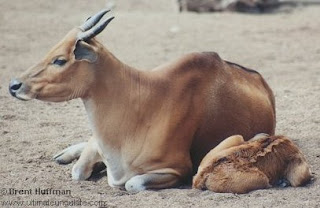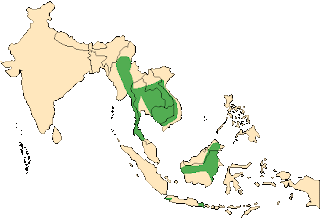
Classification
Kingdom : Animalia
Phylum : Chordata
Class : Mammalia
Order : Artiodactyla
Family : Bovidae
Subfamily : Bovinae
Genus : Bos
Taxonomy
Bos javanicus [d'Alton, 1823].
Citation: Die Skelete der Wiederkauer, abgebildt und verglichen, p. 7.
Type locality: Indonesia, Java.
The taxonomic record (above) is taken from Wilson and Reeder (1993). The banteng has been placed the subgenus Bibos, although recent evidence suggests a closer affinity to domestic cattle in the subgenus Bos [Linneaus, 1758] (Nowak, 1991). Invalid synonyms for B. javanicus include banteng, birmanicus, butleri, discolor, domesticus, leucoprymnus, longicornis, lowi, porteri, and sondaicus (Wilson and Reeder, 1993).
General Characteristics
Body Length: 190-225 cm / 6.3-7.5 ft.
Shoulder Height: 160 cm / 5.3 ft.
Tail Length: 65-70 cm / 2.1-2.3 ft.
Weight: 600-800 kg / 1320-1760 lb.
The banteng exhibits sexual dimorphism, allowing the sexes to be readily distinguished by appearances. Both males and females have white 'stockings' on their lower legs, a white rump, a white muzzle, and white spots above the eyes. The short-haired, rufous-chestnut coat in females and young is smooth, with a dark dorsal stripe. The build is trim and distinctly cattle-like. The horns of females are short and tightly curved, pointing inward at the tips. In mature males, the coat is blue-black or dark chestnut in colour. The horns are long, growing 60-75 cm / 2-2.5 feet long, and arc upwards, connected by a horn-like bald patch on the forehead. There is a hump on the back above the shoulders.
Ontogeny and Reproduction
Gestation Period : 285 days.
Young per Birth : 1
Weaning : At 6-9 months.
Sexual Maturity : At 2-3 years.
Life span : About 20 years.
While in captivity breeding has occurred throughout the year, wild banteng in Thailand mate during May and June.
Ecology and Behavior
While the banteng may be active during the night or day, in areas with heavy human encroachment the herds have become nocturnal. Herds have been recorded feeding throughout the night, pausing to rest and ruminate at intervals. These wild cattle are very shy and retiring, and due to their wariness they are hard to approach. Feeding in open clearings, banteng depend on dense thickets in which to retire for shelter and safety. During the wet seasons, banteng may leave the valleys to forage, heading for forests at higher elevations. As the dry season takes hold, they return to the opener lowlands.
Family group : Herds of 2-40 animals with a single mature male. Other males are live alone or in bachelor groups.
Diet : Grasses, leaves, and shoots.
Main Predators : Dhole.
Distribution
Dense forest and bamboo jungles in Indochina, Borneo, Java, and the Malay Peninsula.
Countries: Bangladesh [RE], Brunei Darussalam [RE], Cambodia, India [RE], Indonesia (Bali; Jawa; Kalimantan), Lao People's Democratic Republic, Malaysia (Peninsular Malaysia [RE]; Sabah; Sarawak?), Myanmar, Thailand, Viet Nam (IUCN, 2002).

Conservation Status
The banteng is listed as endangered (A1cd+2cd, C1+2a) by the IUCN (2002), and is not listed by CITES.
Remarks
These wild cattle have been domesticated in numerous locations, most notably on the island of Bali, where they are known, appropriately, as Bali cattle. Over 1.5 million domestic banteng are thought to exist. Mating between banteng and domestic cattle occurs freely, and the resulting offspring are usually fertile.
Banteng is a Malayan name. Bos (Latin) an ox. -icus (Latin) a suffix meaning belonging to: the banteng inhabits Java, among other islands in Malaya.
French
Banteng (Buchholtz, 1990)
German
Banteng (Buchholtz, 1990)
Literature Cited
Buchholtz, C. 1990. Cattle. In Grzimek's Encyclopedia of Mammals. Edited by S. P. Parker. New York: McGraw-Hill. Volume 5, pp. 360-417.
Corbet, G. B., and J. E. Hill. 1992. the Mammals of the Indomalayan Region: A systematic review. Oxford: Oxford University Press.
Nowak, R. M. [editor]. 1991. Walker's Mammals of the World (Fifth Edition). Baltimore: The Johns Hopkins University Press.
Wilson, D. E., and D. M. Reeder [editors]. 1993. Mammal Species of the World (Second Edition). Washington: Smithsonian Institution Press.
Additional Resources
Alikodra, H. 1987. The ecology of banteng (Bos javanicus) in the National Park of Ujung Kulon. Biotrop Special Publications 30: 161-167.
Ashby, K.R. and Santiapillai, C. 1986. An assessment of the status of the banteng (Bos javanicus) with particular reference to its interaction with the water buffalo (Bubalus bubalis). Tigerpaper 13(4): 10-20.
Ashby, K.R. and Santiapillai, C. 1987. The life expectancy of banteng (Bos javanicus) and buffalo (Bubalus bubalis) in Baluran National Park, East Java, Indonesia. Biotrop Special Publications 30: 151-160.
Ashby, K.R. and Santiapillai, C. 1988. The status of the banteng (Bos javanicus) in Java and Bali. Tigerpaper 15(4): 16-25.
Bowman, D. 1992. Banteng. Australian Natural History 24(3): 16.
Davis, S., and B. Read. 1985. The status of North American captive herds of the banteng (Bovis javanicus). Zoo Biology 4(3): 269-279.
Duckworth, J. W., and S. Hedges. 1998. A Review of the Status of Tiger, Asian Elephant, Gaur, and Banteng in Viet Nam, Lao, Cambodia, and Yunnan (China), with Recommendations for Future Conservation Action. WWF Indochina Programme, Hanoi, Viet Nam.
Halder, U. 1976. Okologie und Verhalten des Banteng (Bos javanicus) in Java. Eine Feldstudie. Mammalia depicta 10, Verlag Paul Parey, Hamburg and Berlin, Germany.
Hedges, S. 1996. Proposal for inclusion of Banteng (Bos javanicus) in CITES Appendix I. Proposal prepared for the IUCN/SSC Asian Wild Cattle Specialist Group, the IUCN/SSC Wildlife Trade Programme, and the Thai Government.
Heng Kimchhay, Ouk Kimsan, Kry Masphal, Sin Polin, Uch Seiha, and H. Weiler. 1998. The Distribution of Tiger, Leopard, Elephant and Wild Cattle (Gaur, Banteng, Buffalo, Khting Vor and Kouprey) in Cambodia. Interm Report: July 1998. Wildlife Protection Office, Phnom Penh, Cambodia.
Payne, J., and C. M. Francis. 1985. A Field Guide to the Mammals of Borneo. Sabah, Malaysia: Sabah Society with World Wildlife Fund Malaysia.
Srikosamatara, S., and V. Suteethorn. 1995. Populations of gaur and banteng and their management in Thailand. Natural History Bulletin of the Siam Society 43(1): 55-83.
Kingdom : Animalia
Phylum : Chordata
Class : Mammalia
Order : Artiodactyla
Family : Bovidae
Subfamily : Bovinae
Genus : Bos
Taxonomy
Bos javanicus [d'Alton, 1823].
Citation: Die Skelete der Wiederkauer, abgebildt und verglichen, p. 7.
Type locality: Indonesia, Java.
The taxonomic record (above) is taken from Wilson and Reeder (1993). The banteng has been placed the subgenus Bibos, although recent evidence suggests a closer affinity to domestic cattle in the subgenus Bos [Linneaus, 1758] (Nowak, 1991). Invalid synonyms for B. javanicus include banteng, birmanicus, butleri, discolor, domesticus, leucoprymnus, longicornis, lowi, porteri, and sondaicus (Wilson and Reeder, 1993).
General Characteristics
Body Length: 190-225 cm / 6.3-7.5 ft.
Shoulder Height: 160 cm / 5.3 ft.
Tail Length: 65-70 cm / 2.1-2.3 ft.
Weight: 600-800 kg / 1320-1760 lb.
The banteng exhibits sexual dimorphism, allowing the sexes to be readily distinguished by appearances. Both males and females have white 'stockings' on their lower legs, a white rump, a white muzzle, and white spots above the eyes. The short-haired, rufous-chestnut coat in females and young is smooth, with a dark dorsal stripe. The build is trim and distinctly cattle-like. The horns of females are short and tightly curved, pointing inward at the tips. In mature males, the coat is blue-black or dark chestnut in colour. The horns are long, growing 60-75 cm / 2-2.5 feet long, and arc upwards, connected by a horn-like bald patch on the forehead. There is a hump on the back above the shoulders.
Ontogeny and Reproduction
Gestation Period : 285 days.
Young per Birth : 1
Weaning : At 6-9 months.
Sexual Maturity : At 2-3 years.
Life span : About 20 years.
While in captivity breeding has occurred throughout the year, wild banteng in Thailand mate during May and June.
Ecology and Behavior
While the banteng may be active during the night or day, in areas with heavy human encroachment the herds have become nocturnal. Herds have been recorded feeding throughout the night, pausing to rest and ruminate at intervals. These wild cattle are very shy and retiring, and due to their wariness they are hard to approach. Feeding in open clearings, banteng depend on dense thickets in which to retire for shelter and safety. During the wet seasons, banteng may leave the valleys to forage, heading for forests at higher elevations. As the dry season takes hold, they return to the opener lowlands.
Family group : Herds of 2-40 animals with a single mature male. Other males are live alone or in bachelor groups.
Diet : Grasses, leaves, and shoots.
Main Predators : Dhole.
Distribution
Dense forest and bamboo jungles in Indochina, Borneo, Java, and the Malay Peninsula.
Countries: Bangladesh [RE], Brunei Darussalam [RE], Cambodia, India [RE], Indonesia (Bali; Jawa; Kalimantan), Lao People's Democratic Republic, Malaysia (Peninsular Malaysia [RE]; Sabah; Sarawak?), Myanmar, Thailand, Viet Nam (IUCN, 2002).

Range Map (Redrawn from Corbet and Hill, 1992)
Conservation Status
The banteng is listed as endangered (A1cd+2cd, C1+2a) by the IUCN (2002), and is not listed by CITES.
Remarks
These wild cattle have been domesticated in numerous locations, most notably on the island of Bali, where they are known, appropriately, as Bali cattle. Over 1.5 million domestic banteng are thought to exist. Mating between banteng and domestic cattle occurs freely, and the resulting offspring are usually fertile.
Banteng is a Malayan name. Bos (Latin) an ox. -icus (Latin) a suffix meaning belonging to: the banteng inhabits Java, among other islands in Malaya.
French
Banteng (Buchholtz, 1990)
German
Banteng (Buchholtz, 1990)
Literature Cited
Buchholtz, C. 1990. Cattle. In Grzimek's Encyclopedia of Mammals. Edited by S. P. Parker. New York: McGraw-Hill. Volume 5, pp. 360-417.
Corbet, G. B., and J. E. Hill. 1992. the Mammals of the Indomalayan Region: A systematic review. Oxford: Oxford University Press.
Nowak, R. M. [editor]. 1991. Walker's Mammals of the World (Fifth Edition). Baltimore: The Johns Hopkins University Press.
Wilson, D. E., and D. M. Reeder [editors]. 1993. Mammal Species of the World (Second Edition). Washington: Smithsonian Institution Press.
Additional Resources
Alikodra, H. 1987. The ecology of banteng (Bos javanicus) in the National Park of Ujung Kulon. Biotrop Special Publications 30: 161-167.
Ashby, K.R. and Santiapillai, C. 1986. An assessment of the status of the banteng (Bos javanicus) with particular reference to its interaction with the water buffalo (Bubalus bubalis). Tigerpaper 13(4): 10-20.
Ashby, K.R. and Santiapillai, C. 1987. The life expectancy of banteng (Bos javanicus) and buffalo (Bubalus bubalis) in Baluran National Park, East Java, Indonesia. Biotrop Special Publications 30: 151-160.
Ashby, K.R. and Santiapillai, C. 1988. The status of the banteng (Bos javanicus) in Java and Bali. Tigerpaper 15(4): 16-25.
Bowman, D. 1992. Banteng. Australian Natural History 24(3): 16.
Davis, S., and B. Read. 1985. The status of North American captive herds of the banteng (Bovis javanicus). Zoo Biology 4(3): 269-279.
Duckworth, J. W., and S. Hedges. 1998. A Review of the Status of Tiger, Asian Elephant, Gaur, and Banteng in Viet Nam, Lao, Cambodia, and Yunnan (China), with Recommendations for Future Conservation Action. WWF Indochina Programme, Hanoi, Viet Nam.
Halder, U. 1976. Okologie und Verhalten des Banteng (Bos javanicus) in Java. Eine Feldstudie. Mammalia depicta 10, Verlag Paul Parey, Hamburg and Berlin, Germany.
Hedges, S. 1996. Proposal for inclusion of Banteng (Bos javanicus) in CITES Appendix I. Proposal prepared for the IUCN/SSC Asian Wild Cattle Specialist Group, the IUCN/SSC Wildlife Trade Programme, and the Thai Government.
Heng Kimchhay, Ouk Kimsan, Kry Masphal, Sin Polin, Uch Seiha, and H. Weiler. 1998. The Distribution of Tiger, Leopard, Elephant and Wild Cattle (Gaur, Banteng, Buffalo, Khting Vor and Kouprey) in Cambodia. Interm Report: July 1998. Wildlife Protection Office, Phnom Penh, Cambodia.
Payne, J., and C. M. Francis. 1985. A Field Guide to the Mammals of Borneo. Sabah, Malaysia: Sabah Society with World Wildlife Fund Malaysia.
Srikosamatara, S., and V. Suteethorn. 1995. Populations of gaur and banteng and their management in Thailand. Natural History Bulletin of the Siam Society 43(1): 55-83.
